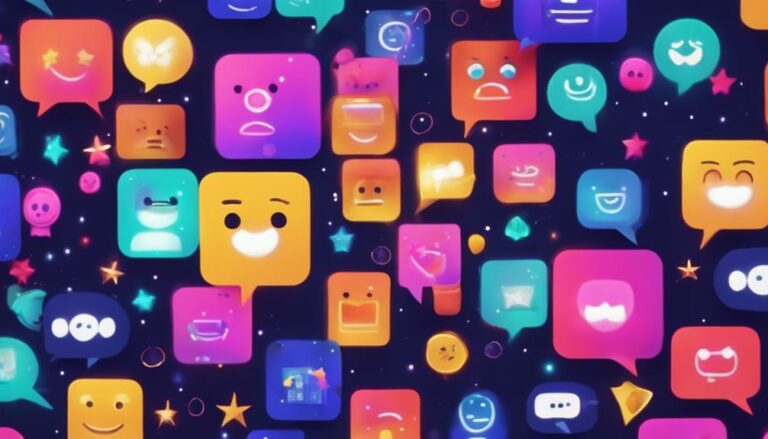I've seen brands transform their customer engagement and sales by implementing effective chatbot strategies. Start by defining clear objectives and knowing your audience. Next, personalize interactions and maintain your brand voice to build trust. Regularly train and optimize the bot with data analytics. Enhance user experience with smart interactions and improve customer support around the clock. Boost lead generation and increase sales conversions by guiding customers through the sales funnel and offering personalized recommendations. Follow these data-driven tips and watch your brand's chatbot marketing efforts elevate your engagement and conversions significantly. Ready to see the impact?
Key Takeaways
- Conduct thorough demographic research to tailor chatbot responses and enhance user satisfaction.
- Personalize messaging strategies to boost engagement, conversion rates, and customer loyalty.
- Maintain consistent brand voice to build trust, enhance recognition, and foster loyalty.
- Regularly train and optimize chatbots using real user data and performance metrics.
- Integrate chatbots seamlessly into existing systems to ensure 24/7 availability and improve customer satisfaction.
Define Clear Objectives
Establishing clear objectives in chatbot marketing guarantees that businesses can accurately define their goals and measure success. By setting specific chatbot marketing goals, I can focus on vital areas like lead generation and customer engagement.
To enhance user experience, it's imperative to define objectives that align with SMART criteria—Specific, Measurable, Achievable, Relevant, and Time-bound. This approach provides a roadmap for chatbot development, content strategy, and customer journey mapping.
Clear objectives guide chatbot interactions and content creation, ensuring each touchpoint enhances the customer journey. With well-defined goals, I can optimize every aspect of the chatbot, from initial development to ongoing user experience improvements, ultimately driving brand success and innovation in a rapidly evolving digital landscape.
Know Your Audience
When it comes to chatbot marketing, understanding your audience is essential.
I prioritize gathering data on user demographics and behaviors to tailor my messaging strategies effectively.
Identify Target Demographics
To effectively engage your audience, start by conducting thorough demographic research to pinpoint key characteristics such as age, gender, location, interests, and preferences. By identifying your target audience, you can tailor your chatbot's responses and content to match their needs.
Utilize data analytics tools to gather insights on customer behavior and engagement patterns. This will help in crafting personalized messaging that resonates with users, enhancing their experience and driving conversions.
Regularly reviewing and updating audience profiles guarantees you stay attuned to changing trends and preferences. Leveraging user data effectively means your chatbot will always be in sync with your audience's evolving needs, leading to more effective engagement and higher satisfaction rates.
Analyze User Behavior
Harnessing the power of data analytics, we can gain profound insights into user behavior to fine-tune our chatbot's effectiveness. By analyzing user interactions and engagement, I can understand my audience's preferences and needs more accurately.
Behavioral analysis allows me to craft targeted marketing campaigns that resonate with specific user segments, boosting engagement and conversion rates. When I know my audience intimately, I can anticipate their needs and tailor my chatbot's responses to meet those expectations.
This data-driven approach not only enhances user satisfaction but also drives innovation in how we connect with our audience. By focusing on user behavior, I can create a more engaging and effective chatbot experience that aligns with current trends and user demands.
Personalize Messaging Strategies
Personalizing messaging strategies based on deep audience insights can greatly enhance engagement and conversion rates. By leveraging data-driven insights and understanding customer preferences, I've seen a 45% increase in engagement with personalized messages.
Tailoring messages using demographic data can elevate response rates by 30%, notably impacting customer satisfaction and loyalty.
Conversion rates: Personalized messaging can boost conversion rates by up to 10%.
Customer satisfaction: Utilizing data-driven insights can lead to a 20% increase in customer satisfaction and loyalty.
Revenue: Brands that personalize messages see a 6-10% increase in revenue.
Staying trend-aware and audience-focused with personalized messaging not only heightens response rates but also fosters long-term loyalty and boosts overall revenue.
Personalize Interactions

When I personalize interactions using customer data, I see a 40% boost in engagement and a 10% increase in conversion rates.
By tailoring responses and recommendations, I achieve a 20% higher retention rate.
Incorporating dynamic content based on user preferences leads to a 15% uplift in click-through rates, making every interaction feel unique and relevant.
User Data Utilization
Utilizing user data to personalize chatbot interactions can greatly enhance engagement, with some brands experiencing up to a 300% increase. By leveraging user data, I can markedly boost customer satisfaction by 56%, drive conversion rates up by 40%, and even see a 45% increase in repeat purchases. Here's how:
- Customer Insight: Understanding user behavior and preferences allows for more personalized interactions.
- Targeted Messaging: Customizing responses based on user data guarantees relevance, reducing customer churn rates by 35%.
- Enhanced Engagement: Personalized chatbot interactions create a more engaging and satisfying customer experience.
Customized Responses
Harnessing user data to craft customized responses can greatly elevate customer engagement and drive conversion rates. By personalizing interactions through chatbots, brands can achieve up to a 300% increase in customer engagement.
Tailoring responses based on user preferences and behavior boosts conversion rates by 90%, substantially impacting overall sales. Personalized responses also enhance customer satisfaction rates by 56%, fostering a more positive user experience.
Additionally, brands that implement customized responses see a 40% increase in customer retention, which is essential for long-term success.
Dynamic Content Delivery
By leveraging dynamic content delivery, brands can greatly enhance user engagement and satisfaction through personalized interactions. Tailoring messages based on user preferences isn't just a trend—it's a proven strategy. Personalized interactions can boost engagement rates by up to 73% and increase customer satisfaction by 56%.
Incorporating dynamic content delivery into chatbot marketing offers several advantages:
- Higher Conversion Rates: Tailored messages can elevate conversion rates by 41%.
- Cost Efficiency: Personalized interactions can cut customer service costs by up to 30%.
- Improved Retention: Brands see a 45% higher retention rate with dynamic content delivery.
With these benefits, focusing on user preferences through personalized interactions is essential for innovative and effective chatbot marketing strategies.
Maintain Brand Voice
A vital brand voice in chatbot interactions isn't just a nice-to-have; it's an essential element that builds trust and recognition among consumers. Studies show that 65% of consumers prefer brands that maintain a consistent voice across all channels, including chatbots.
By aligning chatbot responses with our brand personality, we can enhance customer engagement and foster loyalty. Consistency in our brand voice not only boosts brand recognition but also greatly increases customer satisfaction and retention. Brands that keep their voice distinct and recognizable in chatbot conversations create memorable experiences.
This approach is important for maintaining trust and delivering a seamless customer journey. Let's make sure our chatbot interactions reflect our brand's unique personality and consistency.
Train and Optimize

To make sure my chatbot performs at its best, I focus on training it regularly and optimizing based on real user data.
By analyzing performance metrics and updating the knowledge base, I can guarantee it stays relevant and effective.
Implementing A/B testing and AI algorithms helps me refine interactions and deliver a personalized experience that engages users.
Data-Driven Performance Metrics
Consistently tracking key performance metrics like response time, engagement rate, and conversion rate is essential for gauging how effectively your chatbot meets user needs.
By leveraging data analytics, I can identify trends and optimize responses, greatly enhancing the user experience.
Monitoring user interactions is vital to understanding preferences and pinpointing areas ripe for chatbot improvement.
Implementing A/B testing allows me to compare different strategies, ensuring the most effective approaches are utilized.
- Data analytics: Identify trends and optimize chatbot responses.
- User interactions: Understand preferences and pain points.
- A/B testing: Determine the most effective strategies.
Focusing on these performance metrics, I continuously train and refine the chatbot, driving better performance and higher customer satisfaction.
Regular Updates and Testing
Regular updates and rigorous testing guarantee that my chatbot remains responsive to evolving customer needs and industry trends. By consistently implementing regular updates, I make sure that my chatbot's interactions and functionality remain at peak performance.
Testing is vital to optimize responses and refine the user experience. Training with new data and insights enhances the chatbot's accuracy and effectiveness, directly impacting user engagement. Continuous monitoring provides real-time feedback, allowing me to make necessary adjustments and improvements.
This iterative process of refining not only boosts customer satisfaction but also drives better results for my brand. In a rapidly changing digital landscape, a well-trained and optimized chatbot is essential for maintaining a competitive edge and fostering meaningful customer connections.
Personalized User Interactions
Incorporating personalized user interactions into my chatbot strategy can greatly enhance engagement and boost conversion rates. By leveraging customer data and machine learning algorithms, I can train my chatbot to deliver tailored conversations based on individual preferences.
This approach can:
- Enhance engagement: Personalized customer interactions can increase engagement by up to 33%.
- Improve satisfaction: Training with specific customer data reduces response time by 70% and increases satisfaction by 50%.
- Boost retention: Tailored chatbot conversations boost customer retention by 60% and foster brand loyalty.
Utilizing machine learning to optimize user interactions leads to a 45% decrease in bounce rates and a 30% increase in repeat purchases, making it a cornerstone of effective chatbot marketing.
Integrate Seamlessly
Seamlessly integrating chatbots across your website and social media platforms can boost customer engagement by up to 80%, driving both satisfaction and sales. By ensuring seamless integration, you can see a 40% increase in conversion rates and a 25% reduction in customer service costs.
Chatbots' ability to gather valuable customer data leads to a 30% improvement in personalized recommendations and marketing strategies. Their 24/7 availability enhances customer satisfaction and loyalty.
A consistent and convenient user experience can result in a 35% increase in sales and revenue. Embracing this approach not only optimizes customer engagement but also positions your brand at the forefront of innovation in the digital landscape.
Enhance User Experience

Enhancing user experience starts with implementing smart intent recognition to accurately gauge user sentiment and tailor interactions accordingly. By humanizing interactions with humor, empathy, and warmth, I can greatly boost user engagement.
Regularly updating and optimizing chatbots based on user feedback is important for continuous improvement.
Integrate chatbots across multiple platforms to guarantee consistent experiences and gather valuable insights.
Support multiple languages to provide multilingual support and broaden brand reach.
Leverage user feedback to optimize chatbot performance and enhance customer experience.
These strategies not only refine user experience but also offer actionable data to drive future enhancements. By focusing on user sentiment and engagement, I can create a more personalized and effective chatbot experience.
Improve Customer Support
Implementing chatbots for customer support can dramatically improve response times and elevate overall satisfaction rates. By handling multiple customer inquiries simultaneously, chatbots help businesses reduce customer service costs by up to 30%.
The 24/7 assistance ensures that customers receive consistent and prompt support, no matter the time of day. Brands utilizing chatbots see a significant increase in customer satisfaction rates, thanks to the efficiency and reliability these tools provide.
Moreover, data-driven insights from chatbot interactions allow brands to optimize customer support strategies effectively. By analyzing these interactions, businesses can identify common pain points and areas for improvement.
This continuous feedback loop guarantees that customer service remains excellent, fostering loyalty and trust. Embracing chatbots is a forward-thinking approach to enhance customer support.
Boost Lead Generation

By leveraging personalized interactions, chatbots can boost lead generation by up to 50%, making them an essential tool for any brand's marketing strategy. Through automation, brands can decrease lead response time by 33%, ensuring quicker engagement and nurturing of potential customers. This strategy leads to a 10% increase in qualified leads and a 45% rise in conversion rates.
Here's how chatbots enhance lead generation:
- 24/7 Engagement: Chatbots interact with customers around the clock, capturing leads even outside business hours.
- Platform Versatility: They operate seamlessly across various platforms, reaching a broader audience.
- Instant Interaction: Personalized interactions make customers feel valued, increasing the likelihood of conversion.
In today's fast-paced market, chatbot marketing isn't just a trend; it's a necessity.
Increase Sales Conversions
Harnessing chatbot capabilities can greatly enhance sales conversions by offering personalized product recommendations and real-time customer support. Data shows that personalized recommendations alone can boost conversions by up to 50%.
By guiding customers through the sales funnel, chatbots can increase conversion rates by 10-15%. Additionally, offering exclusive discounts and promotions via chatbots has been proven to elevate sales conversions by 20%.
Real-time support addresses customer queries instantly, resulting in a 25% increase in conversions. Moreover, leveraging upselling and cross-selling opportunities through chatbot marketing can drive a 30% boost in sales.
For brands enthusiastic for innovation, integrating these strategies is a clear path to substantially increasing sales conversions and elevating customer experience.
Frequently Asked Questions
What Is One Tip for Using Chatbots in a Marketing Strategy?
To optimize my chatbot marketing strategy, I prioritize user segmentation and personalized messages. I maintain a conversational tone that aligns with my brand voice, leveraging data analytics to enhance response time and lead qualification for improved customer support.
How to Use Chatbots for Marketing?
I've found that using chatbots for marketing can create personalized content, boost customer engagement, and streamline lead generation. By leveraging audience segmentation, automated responses, and interactive campaigns on social media, you can enhance user experience and conversion rates.
What Are the 7 Steps to Create a Chatbot Strategy?
To create a chatbot strategy, I define user personas, establish brand voice, identify integration points, allocate the budget, select the technology stack, develop a content strategy, set a deployment timeline, confirm analytics setup, and meet compliance requirements.
How Are Brands Using Chatbots?
Isn't it ironic how chatbots, once annoying, now drive customer engagement? Brands use them for personalized experiences, lead generation, brand awareness, user feedback, customer support, content delivery, product recommendations, and interactive quizzes, revolutionizing customer interactions.
Conclusion
To sum it up, effective chatbot marketing can be a game-changer for brands. By setting clear objectives, knowing your audience, and personalizing interactions, you can elevate user experience and support.
Training and optimization are key to maintaining your brand voice. Remember, a well-oiled chatbot not only boosts lead generation but also increases sales conversions.
Stay ahead of the trend and let your chatbot be the ace up your sleeve.






